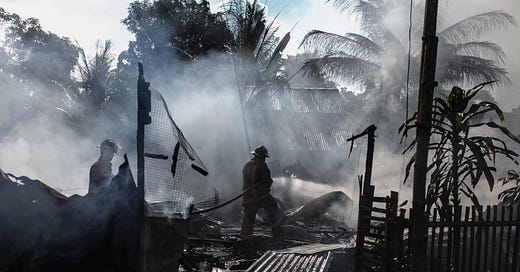Best Ways to Clean Smoke Damage After a Fire
Discover the most effective ways to clean smoke damage after a fire. Learn about professional smoke damage restoration in Williamson County, IL from Restoration Connection.
Experiencing a fire in your home or business can be traumatic, and the aftermath can be just as distressing. While the fire may be extinguished, the damage it leaves behind, particularly smoke damage, can continue to affect your property and health. Lingering smoke residues, foul odors, and structural damage require immediate attention. In Williamson County, IL, where residential and commercial properties vary widely in structure and materials, prompt and professional intervention is crucial.
One of the most important aspects of post-fire cleanup is Smoke Damage Restoration. This process is more complex than many realize. It goes beyond surface cleaning and involves deep cleaning, deodorization, and sometimes rebuilding parts of your property. When handled correctly, it restores safety, air quality, and aesthetics. Let’s explore the best ways to clean smoke damage and why professional services are often your best option.
Understanding Smoke Damage Restoration
Smoke Damage Restoration refers to the complete process of eliminating soot, ash, and smoke odor from a fire-damaged property. When materials burn, they produce different types of smoke residues—wet smoke, dry smoke, protein smoke, and more. Each of these types adheres differently to surfaces, meaning each requires a unique cleaning method. Improper cleaning can worsen the damage or embed harmful residues deeper into surfaces.
In Williamson County, IL, many property owners rely on Restoration Connection, a locally trusted provider, for professional help. Their experienced team utilizes industrial-grade tools, advanced filtration systems, and proven techniques to ensure a safe and effective restoration process tailored to each unique situation.
Step-by-Step Guide to Effectively Clean Smoke Damage
To ensure a successful cleanup, it's essential to follow a systematic approach. Here are the primary steps used in professional smoke damage restoration:
1. Initial Assessment and Damage Inspection
The first step is a detailed inspection of the property. Restoration professionals identify the types of smoke damage present, the extent of the impact, and areas requiring immediate attention. This also involves checking behind walls, under floors, and in ventilation systems to locate hidden residues.
2. Soot and Residue Removal
Once the affected areas are identified, the next step is to remove soot and smoke residues. These particles are acidic and can cause additional damage if left untreated. Restoration experts use HEPA-filtered vacuums, dry sponges, and chemical sponges to lift soot from surfaces like walls, ceilings, and furnishings without spreading it further.
3. Odor Elimination and Air Purification
After physical residues are removed, lingering odors need to be addressed. Smoke odors can seep deep into porous materials like drywall, carpeting, and upholstery. To eliminate these odors, restoration teams use techniques such as ozone treatment, hydroxyl generators, and thermal fogging. These technologies neutralize odor molecules rather than simply masking them.
4. HVAC System Cleaning
Smoke particles often enter HVAC systems, where they can circulate throughout the entire building. Cleaning air ducts and replacing filters is critical to ensuring indoor air quality remains safe. Failure to clean the system can result in recurring odors and airborne irritants.
5. Content Cleaning and Restoration
Personal belongings such as furniture, electronics, clothing, and documents may also be affected. Depending on the severity of the smoke damage, these items are cleaned on-site or transported to a specialized facility. In some cases, dry cleaning or ultrasonic cleaning methods are used to restore delicate items.
6. Structural Repairs and Restoration
Once cleaning is complete, any damaged structures—such as drywall, flooring, or ceilings—must be repaired or replaced. This final step helps return the property to a livable condition and ensures that all remnants of fire and smoke damage have been addressed.
Why Choose Restoration Connection in Williamson County, IL
When it comes to Smoke Damage Restoration, not all services are created equal. Restoration Connection has earned a reputation in Williamson County, IL for providing responsive, thorough, and high-quality fire and smoke restoration services. Their technicians are IICRC-certified and trained in the latest industry techniques. Whether it's a minor kitchen fire or significant structural damage, they approach each job with care and precision.
Conclusion
Dealing with smoke damage after a fire is a complex task that should not be underestimated. It's not just about appearances—residual smoke can pose health risks, compromise air quality, and reduce the value of your property. That’s why investing in professional Smoke Damage Restoration is essential for a complete and safe recovery.
By following a structured restoration process and working with a trusted provider like Restoration Connection, homeowners and business owners in Williamson County, IL can ensure their property is fully restored, both in appearance and safety. Don’t let smoke damage linger—act quickly and professionally to reclaim your space.
FAQs
1. How long does Smoke Damage Restoration take?
The time required depends on the severity of the damage. Minor smoke damage may take a few days, while extensive damage can take several weeks to fully restore.
2. Can smoke damage be harmful to health?
Yes, prolonged exposure to smoke particles and residues can cause respiratory issues, eye irritation, and worsen conditions like asthma. Professional cleaning helps eliminate these risks.
3. Is professional Smoke Damage Restoration expensive?
Costs vary depending on the extent of the damage and services required. However, many insurance policies cover smoke damage, reducing your out-of-pocket expenses.
4. What should I do immediately after a fire?
After ensuring everyone's safety and the fire is extinguished, contact a restoration company to begin assessment and mitigation. Avoid touching or cleaning anything yourself.
5. Will insurance cover smoke damage cleanup?
Most standard property insurance policies cover fire and smoke damage. It’s important to contact your insurance company promptly and document the damage with photos and reports.



